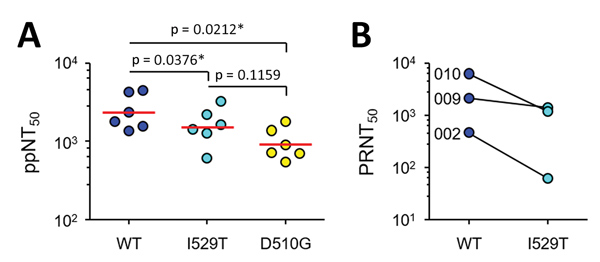Volume 25, Number 6—June 2019
Research
Sequential Emergence and Wide Spread of Neutralization Escape Middle East Respiratory Syndrome Coronavirus Mutants, South Korea, 2015
Figure 3

Figure 3. Increased resistance of Middle East respiratory syndrome coronavirus (MERS-CoV) against antibody-mediated neutralization by spike mutations during the 2015 outbreak in South Korea. A) Neutralizing activity of serum samples against lentiviruses bearing WT and mutant spikes. 50% pseudoparticle neutralization test titers against lentiviruses bearing WT or mutant spikes (I529T or D510G) in serum samples from mice (n = 6) immunized with WT spike antigen are plotted. Mean values are indicated by red lines. Statistical significance was calculated by using analysis of variance with Newman–Keuls post t-test correction. *p<0.05. B) Neutralization activity against MERS-CoV bearing WT or I529T mutant spike mutation in serum samples from 3 recovered patients (P002, P009, and P010) who carried only WT MERS-CoV. ppNT50, 50% pseudoparticle neutralization test; PRNT50, 50% plaque reduction neutralization test; WT, wild-type.
1These first authors contributed equally to this article.
2These authors were co-principal investigators.